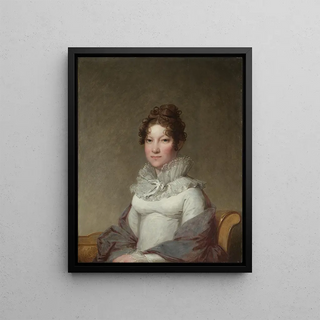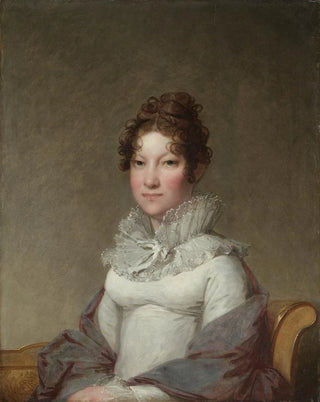Art print | Mary Campbell Stuart - Gilbert Stuart


View from behind

Frame (optional)
Gilbert Stuart's "Mary Campbell Stuart" canvas is much more than a simple pictorial representation; it embodies an era, a personality, and an artistic sensibility that transcend time. This portrait, created in the early 19th century, depicts Mary Campbell Stuart, a woman whose grace and charisma seem to emanate from the canvas. Through this artwork, Stuart manages to capture not only the physical beauty of his model but also her essence, her spirit. In a world where portraits were often symbols of status and wealth, this one stands out for its ability to humanize its subject, to tell a story that goes beyond mere appearance. The delicate light caressing Mary's face, the meticulous details of her dress—all contribute to creating an atmosphere of closeness and intimacy, inviting the viewer to immerse themselves in her universe.
Style and uniqueness of the work
Gilbert Stuart's style is characterized by an exceptional mastery of portraiture, blending realism and idealization. In "Mary Campbell Stuart," he uses a palette of soft colors, where warm tones and delicate shadows combine to bring his model to life. Every brushstroke seems carefully chosen, demonstrating a refined technique that captures textures and nuances of skin, fabrics, and hair. This portrait also stands out for its psychological approach; Stuart does not merely depict a figure, he explores the psychology of his subject. Mary's gaze, both gentle and penetrating, invites reflection and empathy. This portrait thus becomes a mirror of the soul, an open window into human complexity—a feature that elevates the work above the conventions of its time.
The artist and his influence
Gilbert Stuart, born in 1755, is often regarded as one of the greatest American portraitists. His career was marked by iconic works, including the famous portrait of George Washington, which helped shape the image of the American presidency. Stuart's influence extends well beyond his contemporaries; he paved the way for a new approach to portraiture, where the subject is revealed in all its depth. His work has inspired many artists, both in America and beyond.

Matte finish

View from behind

Frame (optional)
Gilbert Stuart's "Mary Campbell Stuart" canvas is much more than a simple pictorial representation; it embodies an era, a personality, and an artistic sensibility that transcend time. This portrait, created in the early 19th century, depicts Mary Campbell Stuart, a woman whose grace and charisma seem to emanate from the canvas. Through this artwork, Stuart manages to capture not only the physical beauty of his model but also her essence, her spirit. In a world where portraits were often symbols of status and wealth, this one stands out for its ability to humanize its subject, to tell a story that goes beyond mere appearance. The delicate light caressing Mary's face, the meticulous details of her dress—all contribute to creating an atmosphere of closeness and intimacy, inviting the viewer to immerse themselves in her universe.
Style and uniqueness of the work
Gilbert Stuart's style is characterized by an exceptional mastery of portraiture, blending realism and idealization. In "Mary Campbell Stuart," he uses a palette of soft colors, where warm tones and delicate shadows combine to bring his model to life. Every brushstroke seems carefully chosen, demonstrating a refined technique that captures textures and nuances of skin, fabrics, and hair. This portrait also stands out for its psychological approach; Stuart does not merely depict a figure, he explores the psychology of his subject. Mary's gaze, both gentle and penetrating, invites reflection and empathy. This portrait thus becomes a mirror of the soul, an open window into human complexity—a feature that elevates the work above the conventions of its time.
The artist and his influence
Gilbert Stuart, born in 1755, is often regarded as one of the greatest American portraitists. His career was marked by iconic works, including the famous portrait of George Washington, which helped shape the image of the American presidency. Stuart's influence extends well beyond his contemporaries; he paved the way for a new approach to portraiture, where the subject is revealed in all its depth. His work has inspired many artists, both in America and beyond.






